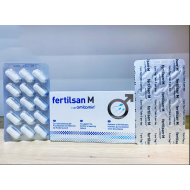
- Stock: In Stock
- Brand: Incepta Pharmaceuticals
- Product ID: Cefuroxime Axetil
100% Secure Payment

This Item is for pre order
Kilbac DS 50 ml
Description
Cefuroxime is one of the bactericidal second generation cephalosporin antibiotic which is active against a wide range of Gram-positive and Gram-negative susceptible organisms including many beta-lactamase producing strains. It is indicated for the treatment of infections caused by sensitive bacteria.
Indications
- Pharyngitis/tonsillitis caused by Streptococcus pyogenes
- Acute bacterial otitis media caused by Streptococcus pneumoniae, Haemophilus influenzae (including beta lactamase-producing strains), Moraxella Catarrhalis (including beta-lactamase-producing strains) or Streptococcus pyogenes.
- Acute bacterial maxillary sinusitis caused by Streptococcus pneumoniae, or Haemophilus influenzae (nonbeta-lactamase-producing strains only)
- Lower respiratory tract infections including pneumoniae, caused by Streptococcus pneumoniae, Haemophilus influenzae (including beta lactamase-producing strains), Klebsiella spp., Staphylococcus aureus (penicillinase- and non-penicillinase-producing strains), Streptococcus pyogenes, Escherichia coli.
- Acute bacterial exacerbations of chronic bronchitis and secondary bacterial infections of acute bronchitis caused by Streptococcus penumoniae, Haemophilus influenzae (beta-lactamase negative strains), or Haemophilus parainfluenzae (beta-lactamase negative strains).
- Skin and Skin-Structure Infections caused by Staphylococcus aureus (penicillinase- and non-penicillinase-producing strains), Streptococcus pyogenes, Escherichia coli, Klebsiella spp., and Enterobacter spp.
- Urinary tract infections caused by Escherichia coli or Klebsiella pneumoniae.
- Bone and Joint Infections caused by Staphylococcus aureus (penicillinase- and non-penicillinase-producing strains).
- Gonorrhea : Uncomplicated and disseminated gonococcal infections due to Neiseria gonorrhoeae (penicillinase- and non-penicillinase-producing strains) in both males and females.
- Early Lyme disease (erythema migrans) caused by Borrelia burgdorferi.
- Septicemia caused by Staphylococcus aureus (penicillinase- and non-penicillinase-producing strains), Streptococcus pneumoniae, Escherichia coli, Haemophilus influenzae (including ampicillin-resistant strains), and Klebsiella spp.
- Meningitis caused by Streptococcus pneumoniae, Haemophilus influenzae (including ampicillin-resistant strains), Neisseira menintitidis, and Staphylococcus aureus (penicillinase- and non-penicillinase-producing strains).
- Surgical Prophylaxis: Prophylaxis against infections in abdominal, pelvic, orthopedic, cardiac, pulmonary, esophageal and vascular surgery where there is increased risk for infection.
Dosage & Administration
Oral :
INFECTIONS DOSAGE DURATION
Tablet
(May be administered without regard to meals)
Adolescents & adults(13 years & above)
Pharyngitis or Tonsillitis 250 mg twice daily 5-10 days
Acute bacterial maxillary sinusitis 250 mg twice daily 10 days
Acute bacterial exacerbation of chronic bronchitis 250-500 mg twice daily 10 days
Secondary bacterial infections of acute bronchitis 250-500 mg twice daily 5-10 days
Uncomplicated skin & skin-structure infections 250-500 mg twice daily 10 days
Uncomplicated urinary tract infection 125-250 mg twice daily 7-10 days
Uncomplicated gonorrhea 1000 mg single dose - - -
Lyme disease 500 mg twice daily 20 days
Paediatric patients (Upto12 years)
(Who can swallow tablets whole)
Pharyngitis or Tonsillitis 125 mg twice daily 5-10 days Acute otitis media 250 mg twice daily 10 days
Acute bacterial maxillary sinusitis 250 mg twice daily 10 days
Suspension
(Must be administered with food. Shake the bottle
well before each use)
Paediatric patients (3 months to 12 years)
Pharyngitis or Tonsillitis 20 mg/kg/day in two divided doses 5-10 days Acute otitis media 30 mg/kg/day in two divided doses 10 days
Acute bacterial maxillary sinusitis 30 mg/kg/day in two divided doses 10 days
Injection :
Adult: 750 mg three times daily by IM or IV injection. In severe infections, dose can be increased upto 1.5 gm three times daily by IV injection. The frequency may be increased to four times daily, if necessary, giving total daily doses of 3 to 6 gms.
Children (above 3 months of age): 30 - 100 mg/kg/day given in 3 or 4 equally divided doses. A dose of 60mg/kg/day is appropriate for most infections.
Neonate: 30 - 100 mg/kg/day given in 2 or 3 equally divided doses.
Surgical prophylaxis: 1.5 gm by IV injection at induction of anaesthesia; up to 3 further doses of 750 mg may be given by IV/IM injection every 8 hours for high risk procedures.
Sequential therapy in adults
Pneumonia: 1.5 gm IV injection twice daily for 2-3 days, followed by 500 mg twice daily (oral) for 7-10 days.
Acute exacerbations of chronic bronchitis: 750 mg twice daily (IM or IV injection) for 2-3 days, followed by 500 mg twice daily (oral) for 5-10 days. (Duration of both parenteral and oral therapy is determined by the severity of the infection and the clinical status of the patient.)
Other recommendations
In Gonorrhoea: Adult: 1.5g as a single dose (as 2 x 750mg injections intramuscularly with different sites, e.g. each buttock).
In Meningitis: Adults: 3gm IV injection three times daily. Children (above 3 months of age): 200-240 mg/kg/day by IV injection in 3 or 4 divided doses reduced to 100 mg/kg/day after 3 days or on clinical improvement. Neonate: 100 mg/kg/day by IV injection reduced to 50 mg /kg/day.
In bone and joint infections: Adult: 1.5 gm IV injection four times daily. Children (above 3 months of age): 150 mg/kg/day (not to exceed the maximum adult dose) in equally divided doses every 8 hours.
In impaired renal function: A reduced dose must be employed when renal function is impaired. Dosage in adults should be determined by the degree of renal impairment and the susceptibility of the causative organism according to the table below -
Creatinine clearance (ml/min) Dose Frequency
> 20 750 mg - 1.5 gm q8h
10-20 750 mg q12h
< 10 750 mg q24h*
* Since Cefuroxime is dialyzable, patients on hemodialysis should be given a further dose at the end of the dialysis.
In paediatric patients with renal insufficiency, the frequency of dosing should be modified consistent with the recommendations for adults.
Side Effects
Generally Cefuroxime is well tolerated. However, a few side effects like nausea, vomiting, diarrhea, abdominal discomfort or pain may occur. As with other broad-spectrum antibiotics, prolonged administration of Cefuroxime may result in overgrowth of nonsusceptible microorganisms. Rarely (<0.2%) renal dysfunction, anaphylaxis, angioedema, pruritis, rash and serum sickness like urticaria may appear.
Precautions
Cefuroxime should be given with care to patients receiving concurrent treatment with potent diuretics & who have history of colitis.
Use in Pregnancy & Lactation
Pregnancy: While all antibiotics should be avoided in the first trimester if possible. However, Cefuroxime has been safely used in later pregnancy to treat urinary and other infections.
Nursing mothers: Cefuroxime is excreted into the breast milk in small quantities. However, the possibility of sensitizing the infant should be kept in mind
Drug Interaction
Concomitant administration of probenecid with Cefuroxime increases the area under the serum concentration versus time curve by 50%. Drug that reduces gastric acidity may result in a lower bioavailability of Cefuroxime and tend to cancel the effect of postprandial absorption.



























%20Pvt.%20Ltd./Movicol-Oral-Powder-190x190.jpg)
